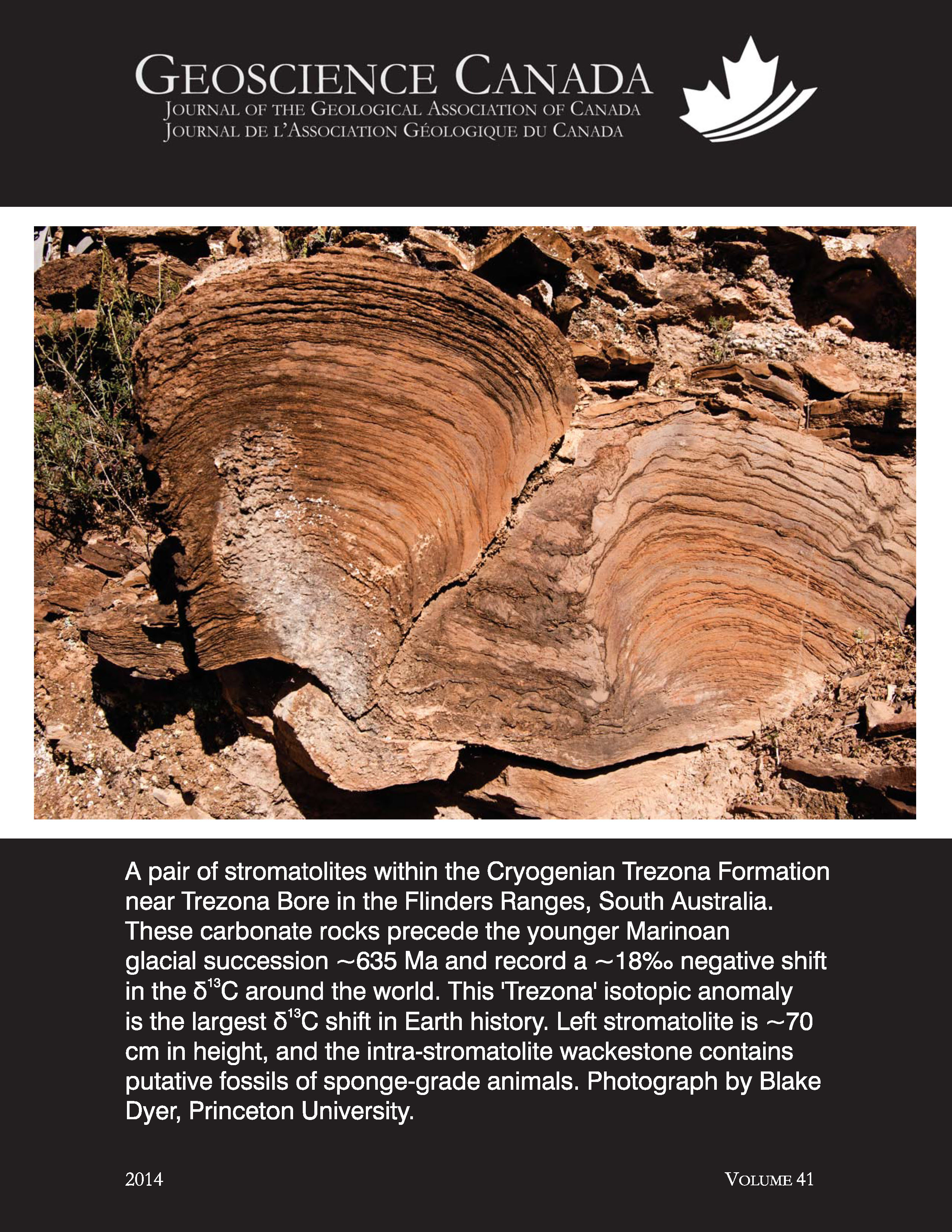Harold Williams Series
Lawrence Head Volcanics and Dunnage Mélange, Newfoundland Appalachians: Origin by Ordovician Ridge Subduction or in Back-Arc Rift?
Published 2014-12-03
How to Cite
Schoonmaker, A., Kidd, W. S., DeLong, S. E., & Bender, J. F. (2014). Lawrence Head Volcanics and Dunnage Mélange, Newfoundland Appalachians: Origin by Ordovician Ridge Subduction or in Back-Arc Rift?. Geoscience Canada, 41(4), 523–556. https://doi.org/10.12789/geocanj.2014.41.053
Abstract
This paper reviews the geological setting and reports new geochemical trace element data from the Ordovician Lawrence Head Volcanics (LHV) and the underlying gabbro sills in the Exploits Group. In combination with existing published analyses and ages of these rocks, the volcanic rocks and sills are indistinguishable in composition and age, and the data are consistent with the hypothesis that they represent the same (mostly E-MORB composition) magmatic event in the early–mid Darriwilian (~465 ± 2 Ma). The LHV and their enclosing strata show regional evidence for: 1) upward decline of volume and grain size of arc-derived volcaniclastic materials over the uppermost interval of turbidite sedimentary strata below the LHV; 2) change to shallow marine conditions locally by the end of the LHV event, followed immediately by significant subsidence, and 3) no evidence of coarse-grained clastic input, nor of normal faulting, during or immediately after LHV magmatism. Ridge–trench interaction (ridge subduction) at a subduction system is consistent with all of these features and spatial distribution of related elements, but a rift (back-arc) origin over a subduction zone can only accommodate the compositions, and is inconsistent with the geological evidence. The Dunnage Mélange (DM) has been interpreted either as olistostromal in a developing back-arc rift basin, or as a subduction accretionary prism. Peraluminous intrusions in the mélange (Coaker Porphyry ― CP) are more readily explained by ridge subduction, and a previously reported zircon age (469 ± 4 Ma) is consistent with the age of the LHV and gabbro sills, also interpreted as products of ridge subduction. Localization of the CP in the eastern area of DM, and of most of the large LHV-derived volcanic blocks in the western DM, suggests a slightly younger age, and perhaps a different mechanism, for the origin of the western DM.SOMMAIRE
Cet article passe en revue le contexte géologique et présente de nouvelles données géochimiques d’éléments traces des roches volcaniques ordoviciennes de Lawrence Head (LHV) et des filons-couches de gabbro sous-jacents du Groupe Exploits. Considérant la combinaison des données d’analyse publiées et des datations de ces roches, les roches volcaniques et les filons-couches sont indiscernables tant en composition qu’en âge, et les données sont compatibles avec l’hypothèse selon laquelle ils représentent le même événement magmatique (principalement E-MORB) du Darriwilien précoce à moyen (~465 ± 2 Ma). Les LHV ainsi que les strates de l’encaissant renferment des indices régionaux qui montrent : 1) que le volume et la granulométrie des matériaux volcanoclastiques d’arc diminuent vers le haut dans l’intervalle supérieur des strates de turbidites sédimentaires sous les LHV; 2) que le changement vers des milieux marins peu profonds localement vers la fin de l’événement des LHV a été suivi immédiatement par une subsidence importante, et 3) qu’il n’existe pas d’indices d’apports clastiques à gros grains, non plus que de formation de failles normales, durant ou immédiatement après le magmatisme des LHV. L’interaction crête-fosse (subduction de la crête) au lieu d’un système de subduction concorde avec toutes ces caractéristiques et la répartition spatiale des éléments reliés, alors qu’une origine de crête (arrière-arc) au-dessus d’une zone de subduction ne peut expliquer que les compositions et qu’elle est incompatible avec l’évidence géologique. Le Dunnage Mélange (DM) a été interprété soit comme un olistostome dans un bassin d’arrière-arc en développement, ou comme un prisme d’accrétion de subduction. Les intrusions hyperalumineuses dans le mélange (Porphyre Coaker — CP), s’explique plus facilement par une subduction de crête, et un âge de datation sur zircon de (469 ± 4 Ma) correspond à l’âge des LHV et des filons-couche de gabbro, aussi interprétés comme produits d’une subduction de crête. La localisation du CP dans la portion orientale du DM, et de la majeure partie des grands blocs volcaniques dérivés des LHV de la portion ouest du DM, suggère un âge légèrement plus jeune, et peut-être un mécanisme différent, pour l’origine de la portion ouest du DM.
